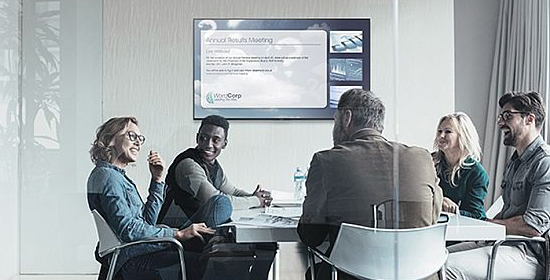
This interesting blog written by Sony highlights the importance of collaborative technologies and how data-driven decision making through new devices and connectivity are shaping the future in workplaces.
Imagine a future where you can walk up to your office and AI adjusts lighting and heating to accommodate the number of people in the building. A smart phone or wearable device tells you exactly what room your next meeting is in and how to get there. You step into the meeting room and your presentation content instantly appears on a display which also automatically connects you to participants from remote locations.
This futuristic vision may not actually be far off.

Collaboration drives innovation.
Better ‘collaboration’ at work does drive innovation. Organisations stated that they see better business collaboration as a key part of their workplace strategy. In this increasingly complex, connected, and fast moving world we live in, businesses must battle to stay ahead of the competition. With innovation being a key source of competitive advantage, it’s clear that we will see more organisations prioritise IT and AV in the design of their workspaces to facilitate faster, smarter, and more intuitive exchanges of information.
Organisations need to satisfy Millennials and attract top talent.
PwC revealed that by 2020, Millennials will make up 50% of the global workforce. These digital natives were raised with smart phones practically attached to their arms, always connected and online. They expect employers to offer state of the art workplace technology that will make them more efficient. Their work behaviour and approach to new technologies will define the future workspaces.

That being said, the coming decade will still see baby boomers, Generation X, and Millennials working side by side. Organisations will need to provide access to technology that attracts and empowers millennials, while also being inclusive of various working styles.
Collecting and using data to drive decision making is becoming increasingly important.
Consultants Frost & Sulliven predict that by 2025 data analytics will be critical for addressing workplace costs and performance. Organisations that combine data with benchmarks and turn that into smart actions will be able to better achieve their strategic property goals. For example the way-finding wearable device I was envisaging earlier could capture employee and visitor data to better optimise space usage, or perhaps the AI solution monitoring lighting and heating could improve energy consumption.

Certain leading-edge companies are already paving the way for the rise of smart, connected workplaces.
Though smart buildings may not be prevalent today, there are several cases where companies have already developed incredible office buildings with IoT (Internet of Things) technologies integrated throughout. A recent project that Sony was involved with from an AV perspective was Deloitte’s HQ building in the Netherlands, The Edge. In this project, everything is connected, from lighting and heating to meeting room devices and coffee machines. It’s projects like this that raise the bar and inspire companies to further innovate their workplace design.
The future is gaining ground. We’re not yet at the stage where offices can provide a completely seamless and tailored workday for each employee or customer, however, as demanding digital natives join the jobs market and assumptions we’ve made about business performance get challenged, the world of work will change.